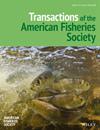Assessing captive spawning strategies for supplementation production of Delta Smelt (Hypomesus transpacificus)
IF 1.4
3区 农林科学
Q2 FISHERIES
引用次数: 0
Abstract
Abstract To support the declining wild population of Delta Smelt, a conservation hatchery has expanded its mission from maintaining a backup population as insurance against extinction to also producing fish for release into the wild. The substantially higher production demands require a balance between producing large numbers of fish while adhering to conservation genetic principles that maximize retention of effective population size ( N e ) and thus overall diversity. We performed spawning experiments at the hatchery to evaluate the genetic consequences of two spawning strategies: 1) a pooled strategy where we fertilized premixed eggs from three dams with premixed milt from three sires and 2) a partial‐factorial strategy where eggs from three dams were mixed and then apportioned among three containers; each container then received milt from one sire. We used genetic parentage analysis of larval offspring to determine the reproductive success of spawners in ten replicate crosses of each strategy. Contributions of parents to offspring were more even in partial‐factorial crosses and consequently resulted in higher N e (average N e = 5.50 ± 0.38; expected N e = 6.0), suggesting its potential for maintaining genetic diversity over time. In contrast, our pooled spawning experiment produced lower and more variable N e values (average N e = 3.86 ± 1.30), demonstrating that this more efficient method of production entails high costs in terms of long‐term genetic management. Treating our experiments as hypothetical pools of fish for release, we combined N e values for pooled or partial‐factorial crosses to calculate the effective size of a release population ( N eR ). Unequal family sizes reduced the N eR for our pooled experiment to half of the expected value, whereas the partial‐factorial experiment N eR was 88% of the expected value. We discuss the benefits and risks of each method and how these can be considered when designing a spawning strategy for Delta Smelt supplementation.圈养产卵策略对三角鱼补充生产的影响
摘要:为了支持不断下降的三角洲胡瓜鱼野生种群,保育孵化场已经将其使命从维持后备种群以防止灭绝扩展到生产鱼类以释放到野外。高得多的产量要求要求在生产大量鱼类和坚持最大限度地保持有效种群大小(N e)和总体多样性的保护遗传原则之间取得平衡。我们在孵化场进行了产卵实验,以评估两种产卵策略的遗传后果:1)混合策略,将三个水坝的预混卵与三个水坝的预混卵受精;2)部分因子策略,将三个水坝的卵混合,然后在三个容器中分配;然后每个容器从一个主人那里收到牛奶。采用遗传亲代分析方法,确定了每种策略的10个重复杂交中产卵者的繁殖成功率。在部分因子杂交中,亲本对后代的贡献更均匀,因而导致更高的N e(平均N e = 5.50±0.38;预期N = 6.0),表明其具有长期保持遗传多样性的潜力。相比之下,我们的混合产卵实验产生了更低和更可变的N e值(平均N e = 3.86±1.30),表明这种更有效的生产方法在长期遗传管理方面需要高昂的成本。将我们的实验作为假设的鱼池进行释放,我们将混合或部分因子杂交的N - e值结合起来计算释放种群的有效大小(N - eR)。不平等的家庭规模使我们的合并实验的净净率降低到期望值的一半,而部分析因实验的净净率为期望值的88%。我们讨论了每种方法的好处和风险,以及在设计三角洲冶炼补充的产卵策略时如何考虑这些。
本文章由计算机程序翻译,如有差异,请以英文原文为准。
求助全文
约1分钟内获得全文
求助全文
来源期刊
CiteScore
2.90
自引率
7.10%
发文量
48
审稿时长
8-16 weeks
期刊介绍:
Transactions of the American Fisheries Society is a highly regarded international journal of fisheries science that has been published continuously since 1872. It features results of basic and applied research in genetics, physiology, biology, ecology, population dynamics, economics, health, culture, and other topics germane to marine and freshwater finfish and shellfish and their respective fisheries and environments.

 求助内容:
求助内容: 应助结果提醒方式:
应助结果提醒方式:


